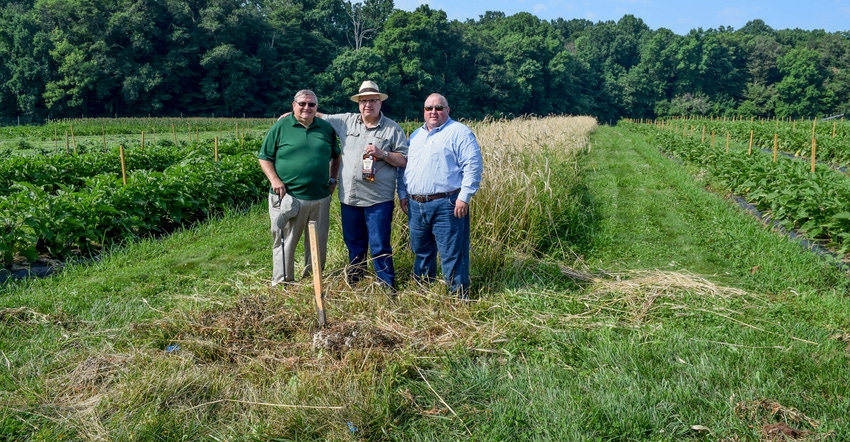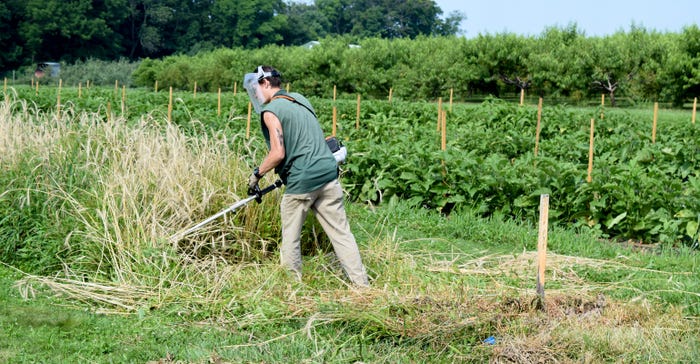
What started as a chance meeting between a college ag educator and a craft whiskey producer has turned into a quest to bring a once-popular heritage rye back to area farms.
Delaware Valley University and Dad's Hat distillery in Bristol are teaming up on a project to reintroduce Rosen rye to farm fields. The goal is to provide farmers a value-added crop for the growing craft distillery market.
For Herman Mihalich, Dad's Hat founder, it's an opportunity to stand out in what has become an increasingly competitive business.
Seeds of research
John Urbanchuk, chairman of the department of agribusiness at Delaware Valley, says Mihalich approached him about growing Rosen rye after touring Dad's Hat in 2015.
"He was interested in growing a heritage variety of rye. I said, 'Yeah, it's something I think we can do,'" Urbanchuk says.
But locating Rosen rye seed wasn't easy. He was only able to get 5 grams of seed from USDA's crop repository in South Dakota.
"It is about as much as you would get in a small pack of plant seed in a hardware store. We're talking about less than a handful of seeds," he says.
 ROSEN HARVEST: Jacob Godshall, a Delaware Valley student, helps to harvest the Rosen rye in July.
ROSEN HARVEST: Jacob Godshall, a Delaware Valley student, helps to harvest the Rosen rye in July.

Rosen rye was brought over from Russia in the late 19th century. It was grown in Pennsylvania, Ohio and Michigan, but fell out of favor in the mid-1920s due to Prohibition.
In the fall of the 2015, Urbanchuk, along with Mihalich and Scott Smith, general farm manager for Delaware Valley, grew modest plantings of Rosen rye. Urbanchuk grew it in his backyard garden while Smith planted seeds in a high tunnel at one of the university's farms.
Those plantings were harvested the summer of 2016.
Growing progress
With so few Rosen rye seeds to plant, Urbanchuk says the initial goal was to grow enough plants to get more seeds for the following year.
A typical Rosen rye plant has about six heads, he says. Each head produces about 30 seeds, though some will produce more and others less.
"The whole idea of this thing is you're propagating, basically multiplying the operation. The thing about it is it takes time to do that. It's basically one crop a year, so it just takes time," he says.
By the end of the second harvest, in 2017, Urbanchuk says the plantings produced 8.5 pounds of seed.
The third planting was done in the fall of 2017. This planting was crucial in that it allowed Smith, for the first time, to plant seed in a field without the protection of a high tunnel.
 EXTRA CREDIT: Delaware Valley students Katherine Kusant, Victoria Behm and Kaytlin Mattern harvest Rosen rye on campus.
EXTRA CREDIT: Delaware Valley students Katherine Kusant, Victoria Behm and Kaytlin Mattern harvest Rosen rye on campus.

"We're just trying to get enough seed to do a practical farm situation," Smith says.
The latest plants were harvested in July. The plants are threshed at Castle Valley Mill near Doylestown, an 18th century mill that has been restored and is operational.
Nibbles of farm data
Urbanchuk thinks this summer's harvest has produced, at the very least, 30 pounds of seed.
"I think we will get 40 to 50 pounds," he says.
With that much seed, Smith says he'll be able to do a farm-level planting of Rosen rye sometime in October. "It will be planted by a machine, small-scale horticulture equipment, primary tillage," he says, adding that it will be a half acre in size at most. "Instead of a grain drill, we will end up using a slot seeder or grass seeder."
Rye has not been developed as much as wheat, triticale or barley because it has little market demand, he says. Given that the first planting in a field was so small, Smith says it's too early to tell what sort of applications it will be suited for. But just looking at the initial harvested plants, Smith says he has high hopes.
"It grows just like the rye people are growing as cover crops. If you get it in early, it seems like it has good winter hardiness," he says. "The straw length has good length to it, ample enough straw for bedding. It seems like it has good cover crop abilities to take up nutrients and cover the soil."
Good libations?
Initial nutritional and chemical analyses of the plants show that Rosen rye is like other varieties of rye.
"The question is there going to be a flavor difference in there," Urbanchuk says.
That's what Mihalich is counting on, something that will differentiate his distillery from others.
 RYE REVIVAL: The goal of the joint project is to see if Rosen rye can be grown for the growing distillery market.
RYE REVIVAL: The goal of the joint project is to see if Rosen rye can be grown for the growing distillery market.

Craft distilleries have seen a resurgence in popularity in recent years. According to data from the American Craft Spirits Association, the number of craft distilleries in Pennsylvania jumped from 46 in 2016 to 62 in 2017. New York state also has a growing industry with 104 craft distilleries at the end of 2016.
Mihalich says his whiskey recipe is made up of 80% rye grains, 15% barley and 5% malted rye. Most of his local rye comes from farms in Bucks County, the largest being Meadow Brook Farms in Riegelsville. "The yield is one component, but most importantly what we're looking for is flavor," Mihalich says.
He hopes to do a small fermentation of this summer's harvest to see what of kind flavor Rosen brings.
Nevada Mease, owner of Meadow Brook Farm, says he connected with Mihalich through word of mouth.
"I had heard that he was looking for cereal rye. I happened to be growing some at the time," Mease says.
Mease grows mostly hay for the equine sector — 800 acres — but he's devoted 200 acres to growing cereal rye for Mihalich. Planting is usually done in September and harvested the following July. It's part of a crop rotation that includes a multispecies cover crop after the rye, then corn or soybeans the following spring.
Mease says he could probably grow a lot more cereal rye for his local mill in Kempton, about an hour away, and would likely make more money. But growing for Mihalich guarantees him a stable price.
"We agree on a price and move forward," he says. "I'm not necessarily as susceptible to fluctuations in the market."
But it's not everyone, he says, adding that he grows essentially what is needed of him in a given year.
"You really have to be flexible in working with them to meet their needs and wants. It takes some patience and understanding," he says.
For Urbanchuk, the project is an example of building a potentially new ag market from the ground up.
"It is experimental agriculture. It builds a good relationship with the business community. This is value-added agriculture at its best," he says.
About the Author(s)
You May Also Like






